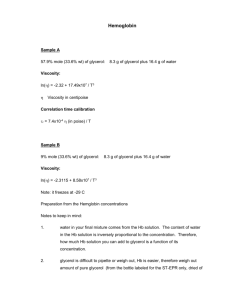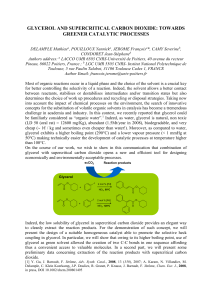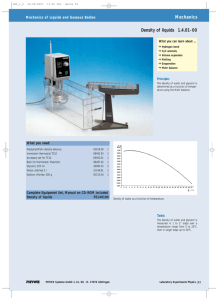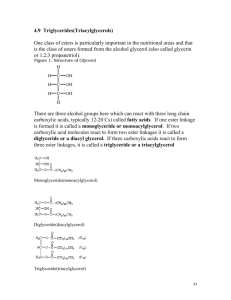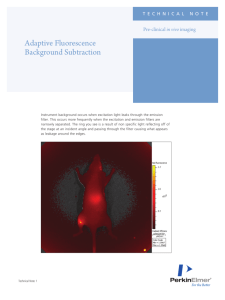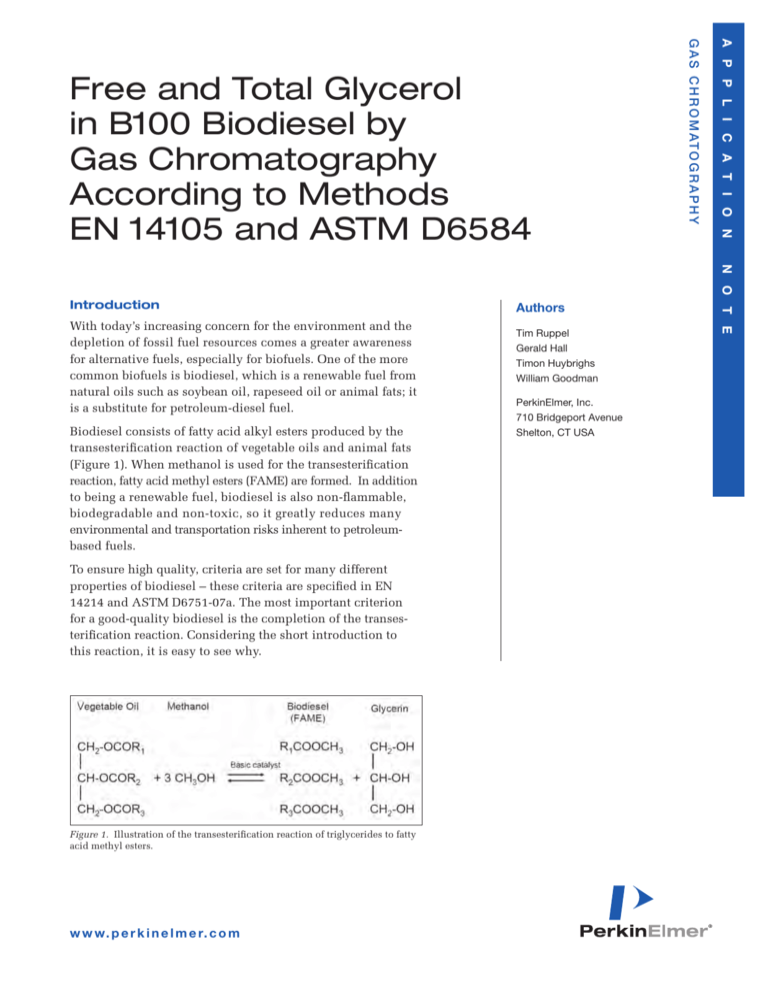
Biodiesel consists of fatty acid alkyl esters produced by the
transesterification reaction of vegetable oils and animal fats
(Figure 1). When methanol is used for the transesterification
reaction, fatty acid methyl esters (FAME) are formed. In addition
to being a renewable fuel, biodiesel is also non-flammable,
biodegradable and non-toxic, so it greatly reduces many
environmental and transportation risks inherent to petroleumbased fuels.
To ensure high quality, criteria are set for many different
properties of biodiesel – these criteria are specified in EN
14214 and ASTM D6751-07a. The most important criterion
for a good-quality biodiesel is the completion of the transesterification reaction. Considering the short introduction to
this reaction, it is easy to see why.
Figure 1. Illustration of the transesterification reaction of triglycerides to fatty
acid methyl esters.
w w w. p e r k i n e l m e r. c o m
Authors
Tim Ruppel
Gerald Hall
Timon Huybrighs
William Goodman
PerkinElmer, Inc.
710 Bridgeport Avenue
Shelton, CT USA
N O T E
With today’s increasing concern for the environment and the
depletion of fossil fuel resources comes a greater awareness
for alternative fuels, especially for biofuels. One of the more
common biofuels is biodiesel, which is a renewable fuel from
natural oils such as soybean oil, rapeseed oil or animal fats; it
is a substitute for petroleum-diesel fuel.
A P P L I C A T I O N
Introduction
G A S C H R O M AT O G R A P H Y
Free and Total Glycerol
in B100 Biodiesel by
Gas Chromatography
According to Methods
EN 14105 and ASTM D6584
When the triglycerides react with methanol, first, the
corresponding diglycerides are formed together with
the fatty acid methyl ester (FAME). The reaction continues and the diglycerides lose a second FAME and
the monoglycerides are formed. Finally, a third FAME
will be lost resulting in the free glycerol. Thus, incomplete reaction will give rise to un-reacted triglycerides
from the parent vegetable oil or fat and the intermediates mono- and diglycerides. These are referred to as
bound glycerol. Another contaminant found in the
final biodiesel is remaining glycerol that has not been
removed from the biodiesel during the water washing
step. The latter is referred to as free glycerol. The sum
of the bound and the free glycerol is referred to as total
glycerol.
This paper will present the analysis of free and total
glycerol by GC-FID following the methodology of both
EN 14105 and ASTM D6584. Analysis of calibration
standards and example biodiesel samples will be presented.
Experimental
Sample preparation is a vital step in this analysis.
The glycerol, mono-, di- and triglycerides must be derivitized to reduce their polarity and improve the thermal
stability of the molecule. The derivatization technique
used is silylation. The derivatization reagent to be used
is MSTFA (N-methyl-N-(trimethylsilyl)trifluoroacetamide)
– the reaction involves the replacement of the active
hydrogen of the hydroxyl-group by a trimethylsilyl-group.
The calibration and internal standards are prepared
in pyridine, according to the EN and ASTM procedure.
Prepared calibration solutions are readily available
(PerkinElmer Part No. N9331040) – this will simplify
method setup, reduce preparation time, minimize the
possibility of human error and eliminate the need to
prepare dilutions.
The derivatization procedure for both standards and
samples is identical. Weigh approximately 100 mg of
sample or standard into a vial and record the actual
weight. Internal standards are added according to the
EN or ASTM specification, and 100 μL MSTFA (derivatization reagent) is finally added. The samples and
standards are allowed to stand for 20 min at room temperature to allow the derivatization reaction to complete.
Following derivatization, heptane is added and the vial
is capped and shaken. The standards and samples are
now ready for analysis.
2
Equally important to the success of this analysis are the
instrumental conditions, supplies and the gas chromatograph
(GC) configuration. As is clear from the previous discussion,
the components analyzed are not the most favorable
for gas chromatography. The high-boiling and thermallylabile compounds require a tightly-controlled injection
technique. In GC, the most suitable injection technique
to achieve a reproducible and controlled injection is the
cool on-column injection. The instrumentation used in
this paper is the PerkinElmer® Clarus® 600 GC fitted with
the programmable on-column injector.
The analytical column used in this application must
meet two major requirements:
1. The internal diameter of the column needs to be
sufficiently wide to allow on-column injection
2. The column must withstand high oven temperatures
Table 1. Detailed Instrument Conditions.
Sample Introduction
PSS Injector
Inlet Program Initial Temperature
Hold Time 1
Ramp 1
60 ˚C
1.00 min
15 ˚C/min
Inlet Program Intermediate Temperature
Hold Time 2
Ramp 2
300 ˚C
0.00 min
30 ˚C/min
Inlet Program Final Temperature
380 ˚C
Column Flow
3 mL/min
Injection Volume
1 µL
Gas Chromatograph
PerkinElmer
Clarus 600 GC
Oven Program Initial Temperature
Hold Time 1
Ramp 1
50 ˚C
1.00 min
15 ˚C/min
Oven Program Temperature 2
Hold Time 2
Ramp 2
180 ˚C
0.00 min
7 ˚C/min
Oven Program Temperature 3
Hold Time 3
Ramp 3
230 ˚C
0.00 min
10 ˚C/min
Oven Program Final Temperature
Hold Time 4
370 ˚C
5.00 min
Equilibration Time
0.0 min
Column
Elite-Biodiesel M,
14 m x 530 µm x 0.16 µm film
Pre-column
Built-in 2 m
Integra-Gap
Carrier Gas
Helium
FID Temperature
H2 flow
Air flow
Range
Attenuation
380 ˚C
45 mL/min
450 mL/min
1
-5
You can achieve this 2 ways: a 0.32 mm i.d. fused
silica analytical column butt connected to a 0.53 mm
i.d. guard-column; or a metal analytical column with
0.53 mm i.d. and integrated guard column. The second
option, which is used here, is preferable. The metal
column eliminates the physical connection between the
analytical column and the guard-column, reducing leaks
and breakage. Additionally, the metal capillary column
withstands higher oven temperatures, offering a more
robust and reliable long-term solution.
Results
The GC analysis of free glycerol, internal standards,
mono-, di- and triglycerides identifies each analyte by
its retention time. The retention time is determined by
the analysis of a known reference standard. Reference
standards are also used to generate a calibration curve,
which relates FID response to % weight in the samples.
The quantification of glycerol, mono-, di- and triglycerides requires a four-level calibration curve for EN 14105
and a five-level calibration curve for ASTM D6584. An
internal-standard calibration is required by both methods.
Table 2. Summary of Calibration Results for Free and Total
Glycerol Following Both EN and ASTM Methodology.
Calibration Summary
Linearity (R2) Linearity (R2)
EN 14110 ASTM D6584
(4-Point Calibration) (5-Point Calibration)
Glycerol
0.9999
0.9999
Total Monoglycerides
0.9999
0.9984
Total Diglycerides
0.9999
0.9987
Total Triglycerides
0.9985
0.9945
In this paper, calibration curves presented for both
EN 14105 and ASTM D6584 (Table 2) demonstrate
excellent linearity, R2 > 0.99 for each analyte. Glycerol
is quantified as a single peak, with butanetriol as the
internal standard. The monoglycerides are calibrated as
a timed group of the 5 monoglycerides, with tricaprin as
the internal standard. Total monoglycerides cannot be
calculated as a summed time group due to co-elution of
the C24 ester. The di- and triglycerides are quantified as
timed groups, also with tricaprin as the internal standard.
The calibration plots are saved in the data processing
method of TotalChrom® Chromatography Data Systems
(CDS) – a calibration plot is presented in Figure 2.
Figure 2. Example calibration plot for total triglycerides following
EN 14105.
An example chromatogram of a calibration standard is
pictured in Figure 3 (Page 4): glycerol and butanetriol
are the first two peaks (callout box 1); following that,
monoolein, tricaprin (internal standard), two diglyceride
peaks and a single triglyceride peak (callout box 2) elute.
The calibration standards only include 1 of the 5 monoglycerides; EN 14105 requires that a mixture of all 5
monoglycerides be analyzed to determine the retention
time of each experimentally, for positive identification.
The ASTM methodology uses relative retention-time
data to identify each monoglyceride.
This paper includes the analysis of 2 different biodiesel
samples – a washed soy biodiesel and an unwashed used
vegetable-oil biodiesel (Figures 4 and 5 respectively). In
the washed soy biodiesel sample (Figure 4 - Page 4), the
internal standard peaks are clearly visible, along with
a cluster of peaks for the FAME content of the sample
(9.5-15 min). There are no visible peaks for either free or
bound glycerol. This is indicative of a complete reaction
and washing. Insufficient washing would demonstrate
increased glycerol content. An incomplete transesterification would result in mono- di- and triglycerides
detection. In this case, the production facility has a
controlled process and a final product which will
meet both ASTM and EN standards.
A biodiesel sample without complete transesterification
and washing is pictured in Figure 5 (Page 5). The result
is large peaks corresponding to glycerol (callout box 1),
monoglycerides (callout box 2), di- and triglycerides
(callout box 3). There is also an increase in the presence
of matrix peaks (broad peaks around 20 and 22 minutes).
w w w. p e r k i n e l m e r. c o m
3
In this case, the production facility needs to modify their
procedures and improve the washing step of the process.
This will complete the reaction and remove residual
glycerol. It would be expected that this sample will have
elevated methanol and potassium hydroxide levels, also
as a result of incomplete washing.
The final step in the free and bound glycerol analysis is the
reporting of % weight results. EN 14105 and ASTM D6584
present detailed calculations for this determination. The
PerkinElmer TotalChrom CDS, used here, will perform the
calculations and report the results. An example free-andbound-glycerol report is pictured in Figure 6 (Page 5).
Figure 3. Free and total glycerol calibration standard.
Figure 4. Sample biodiesel in which the transesterification reaction was completed.
4
Figure 5. Sample biodiesel in which the transesterification reaction is incomplete.
Conclusion
As the distribution of biofuels, particularly biodiesel,
expands, the focus on quality becomes more important.
Biodiesel is a substitute for petroleum-based diesel fuel
– however, the methods to determine fuel quality are
different than the traditional methods for the analysis
of petroleum fuels. In this paper, the analysis of free
and bound glycerol by EN 14105 and ASTM D6584
was presented. The Clarus GC configured with an oncolumn injector, flame ionization detector and metal
biodiesel capillary column provided the platform for
analysis. The system calibration demonstrated linear
response for glycerol, mono-, di- and triglycerides. The
automation of TotalChrom CDS simplified the calculation and result reporting, delivering a simple report
with the percent weight of free and bound glycerol.
Figure 6. Example TotalChrom report for free and bound glycerol.
PerkinElmer, Inc.
940 Winter Street
Waltham, MA 02451 USA
Phone: (800) 762-4000 or
(+1) 203-925-4602
www.perkinelmer.com
For a complete listing of our global offices, visit www.perkinelmer.com/lasoffices
©2008 PerkinElmer, Inc. All rights reserved. The PerkinElmer logo and design are registered trademarks of PerkinElmer, Inc. Clarus, PerkinElmer and TotalChrom are registered trademarks
of PerkinElmer, Inc. or its subsidiaries, in the United States and other countries. All other trademarks not owned by PerkinElmer, Inc. or its subsidiaries that are depicted herein are the
property of their respective owners. PerkinElmer reserves the right to change this document at any time without notice and disclaims liability for editorial, pictorial or typographical errors.
008387_01



